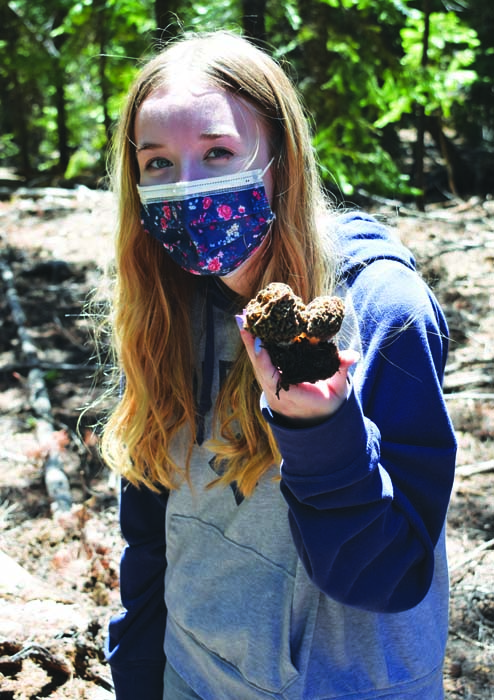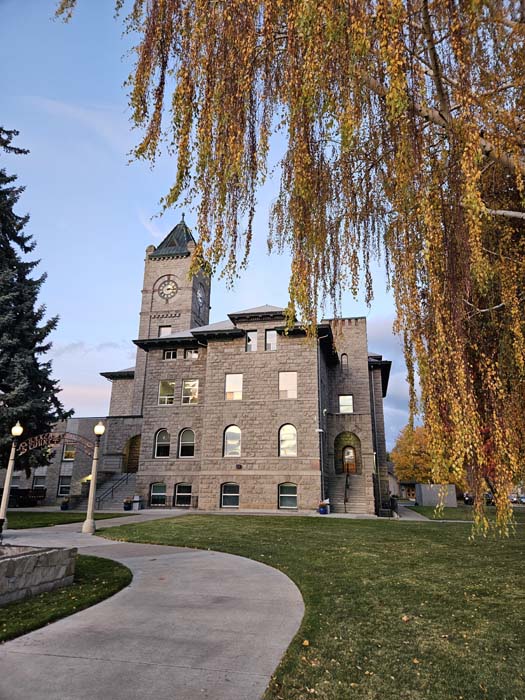Forests & Fungus
Published 3:34 pm Monday, May 17, 2021

- Megan Hurley shows off her find of morel mushrooms during a field trip on May 13. In addition to hunting for morels, the students had sessions with a botanist and entomologist.
Nicole Sullivan couldn’t quit smiling as her students set out to plant some trees. The source of her joy was one word — “hoedad” — that drifted from one group of kids to the next.
Trending
The word is the name of a special tool workers use to plant seedlings.
On Wednesday, May 5, Sullivan’s advanced biology students from Baker High School worked with Bill Mitchell, a Forest Service employee and former teacher, to plant about 300 western white pine seedlings.
The location was just off the Anthony Lakes Highway in a logged area known as the East Face Project.
Trending
After outfitting the students with hard hats, Mitchell distributed necessary tools and gloves. Then he demonstrated the proper way to plant a seedling.
“The clock’s ticking,” he told the group. “They need to get in the ground in the next hour.”
Mitchell used a hoedad to loosen the soil, then dug a good-sized hole to accommodate the seedling’s roots. He tamped the dirt around the tree and made sure it was secure.
As a test, he planted one the wrong way as students hollered out criticism to point out his mistakes.
Armed with trees and tools, the group hiked away from the road to start planting the seedlings.
Before choosing a spot, each group looked up to ensure there was space for a tree, then looked around to make sure the seedling wasn’t too close to a slash pile.
The team of Majestic Grove and Iriana Rosales worked fast once they chose a location.
Grove talked in low tones as she gently lowered the seedling into the ground and filled the hole.
“There we go,” she said, securing soil around the base of the tree.
Mitchell said western white pines are not common these days because the species, which used to be abundant in this area, were highly prized for lumber.
As part of the lesson, Mitchell helped the classes identify types of trees. Sullivan had the students take selfies with at least five different species.
This field trip fits with the class’s unit on botany and fungi.
“We’ve been covering basically the entire plant kingdom,” Sullivan said.
Foraging for fungi
The next week, on Thursday, May 13, Sullivan’s advanced biology classes headed to a different part of the forest near Sumpter. This time they weren’t planting — instead they were searching for the prized morel mushroom.
In the first 10 minutes off the bus, Anna Belding came running up to Sullivan with her prize.
It was a morel, all right, but it was less than 2 inches tall.
“I was looking really hard!” Belding said.
She and her group later loaded a bag full of morels — most much larger than her first fungal find.
As the students spread out across the mountainside, one group relied on advice from freshman Lily Gately, who has been mushroom hunting with her family.
“All these cones look like morels,” Gately said, after inspecting a spot on the ground.
Nearby, junior Gus Terteling peered close at the forest floor.
“I feel they should be in flat, sunny areas, by water. Which is not where we are,” he said.
Throughout the morning, each group took a turn with two employees from the U.S. Forest Service.
Lanny Flaherty, who focuses on botany and conducts field studies, talked about fungi.
Lia Spiegel, an entomologist whose work area includes the Wallowa-Whitman, Umatilla and Malheur national forests as well as federal land managed by the Bureau of Land Management in Eastern Oregon, talked about the world of insects. Her specialty is bark beetles and defoliators — both of which cause illness in the forests of Eastern Oregon.
Flaherty provided a brief overview about mushrooms before the students headed off to search.
The mushroom, he said, is the fruiting body of a fungus growing underground.
“It’s more equivalent to an apple on a tree,” he said.
And just like an apple with seeds, the mushroom’s job is to reproduce by spreading spores.
“You help fungi by harvesting and carrying them around,” Flaherty said.
As part of his talk, Flaherty also gave a bit of career advice for anyone interested in natural resources. He didn’t intend to work for the Forest Service, he said, but enjoys searching for fragile or endangered plants prior to a planned project, such as logging.
“I like being out in the field. I like to look for rare things,” he said. “I never thought someone would pay me to go on a treasure hunt every day.”
During the session with Spiegel, students were asked to find evidence of insect damage.
Terteling quickly handed over a stick marked with gouged lines.
Spiegel said it showed the path of a female beetle. The deep lines were where the beetle chewed the wood, and the shallow marks were where she laid her eggs.
Spiegel showed students more evidence with a display of tree bark and the beetles that caused the damage.
“Every tree has its own bark beetle,” she said.
She also helped the students catch and identify insects in the surrounding grass and trees.
Then, armed with knowledge of fungi and insects, the science students set off on their true mission: find the morels.
Megan Hurley and Terteling kept hiking higher on the mountain on the advice of Belding’s group, which had a nice collection when they took a break for lunch.
Just as Terteling announced they had 19 minutes before the bus had to leave, Hurley crouched and nudged a dirt-colored lump beside a fallen tree.
“I think … ” she said.
Sure enough, she’d found a patch of morels.
Terteling came to see and found his own morel about the same size as Belding’s first 2-inch specimen.
“That is going to feed my family tonight!” Terteling claimed as he sliced through the stem and plopped the prize into his bag.









